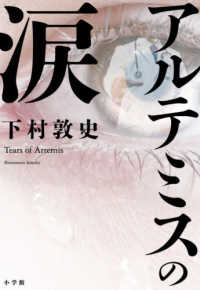- ホーム
- > 洋書
- > 英文書
- > Nature / Ecology
基本説明
A few repeat authors describe brand new aspects of their research, while a new group covers recently developing aspects of symbiotic relationships, including the recent "bug in a bug" mealy bug case, and two new examples of using symbionts in crop protection.
Full Description
Summarizing current knowledge on symbiotic organisms in the biology of insects, Insect Symbiosis, Volume IIdescribes the diversity of symbiotic bacteria associated with pests such as whiteflies, aphids, mealybugs, psyllids, and tsetse flies. The book illustrates how symbiosis research has important ramifications for evolutionary biology, physiology, parasitology, genetics, and animal behavior and is especially relevant to the control of agricultural and disease-carrying pests.
In this second volume, a few repeat authors describe brand new aspects of their research, while a new group covers recently developing aspects of symbiotic relationships. The book includes updated information on Wolbachia biology and how it influences insect life, supplies two new examples of using symbionts in crop protection, and discusses the recent "bug in a bug" mealy bug case. The book provides analysis and synthesis of cutting-edge research in insect symbiosis that sheds light on the evolution of the host/symbiont relationship, and in turn, on the general study of evolution, physiology, and genetics.
Contents
Symbiosis as a Mechanism of Evolution. CFB Bacteria. Symbionts in Cockroaches. PSR Factors in Insects. Bacteria Live Inside Bacteria in a Mealybug. Diversity of Symbionts in Diverse Insect Species, Primary Symbionts, Secondary Symbionts, Arsenophonus, Chlamydia-Like Bacteria. Evolution of Insect Symbionts Genomes. Ants, Agriculture, and Antibiotics: An Ancient Quadripartite Symbiosis. The First Insect Wolbachia Genome. The First Nematode Wolbachia Genome. Comparative Wolbachia Genomics. Tsetse Secondary Symbionts, Mainly Sodalis. Insect-Transmitted Plant Pathogenic Mollicutes. Photorhabdus Genome, Toxins Entomopathogenic Nematodes. Host Plant Specialization Governed by Facultative Symbiont. Locusts and Gut Bacteria. Bacteria Invade Mitochondria of Ticks. Termite Symbiotic Systems. The Applied Biology of Wolbachia. Paratransgenesis Applied to Control Insect-Transmitted Plant Pathogens: The Pierce's Disease Case.








